No, I haven’t seen the TV series (yet), thanks for asking.
But having many times seen the haunting pictures of the city of Pripyat, abandoned after the Chernobyl disaster in 1986, we could not resist the chance to take a tour to see the place for ourselves while on our trip to Kiev. We chose the two day tour (one day options are available) on the grounds that this is a once in a lifetime trip and we wanted to see as much as possible while we were there. We booked with Chernobylwel.com and can thoroughly recommend them for their professionalism and emphasis on safety, because while this is a photo opportunity, it’s also a still a highly radioactive site, so it’s important to follow the rules.
We started from Vokzal at 7.30am with a group of ten. On the 120km journey north, we were given a short “newspaper” of facts about the accident to read, followed by a video documentary to provide more context.

The first checkpoint is at the 30km exclusion zone. Everything becomes a little more real at this point as you realise you are passing through a military checkpoint and are equipped with a dosimeter that measures and records your radiation exposure. Our tour company had submitted all their paperwork to the checkpoint in advance so despite the large number of tour buses parked by the barriers, we passed through quickly.
Once through the checkpoint, the roads are empty and thickly lined with forest. There’s next to no traffic apart from tour buses and military vehicles. Sometimes you catch a glimpse of a structure through the trees, but mostly you feel the eeriness of the emptiness of the road.
Our first stop was an abandoned village, where we had to make our way down an overgrown path. It felt like something from a fairy tale, where the people had disappeared and the forest had swallowed the houses up. A few scattered items remain, left behind by the departing residents and unwanted by those who came later scavenging for abandoned goods. The buildings still remained in reasonable shape considering they had had no maintenance for 30-odd years.

Our second stop was at Duga, the Soviet radio listening station. Duga was located in the town of Chernobyl-2, a secret military town marked on maps as an abandoned Pioneer camp. However like many cold war secrets, Duga wasn’t a secret to the West. It’s location was known, and the distinctive sound it made when tapping into broadcasts earned it the nickname of the Russian Woodpecker.

Since 2012 it is not permitted to go inside any of the buildings in the exclusion zone.
However…
In Chernobyl-2 we visited the military buildings where the “listening” took place, the long corridors now ghostly empty, anything militarily important now removed. It felt strange to be walking around in a monument to cold war militaristic paranoia, in a town so secret it’s location wasn’t given on maps. In Soviet times, foreign tourists would never have made it anywhere near this place.
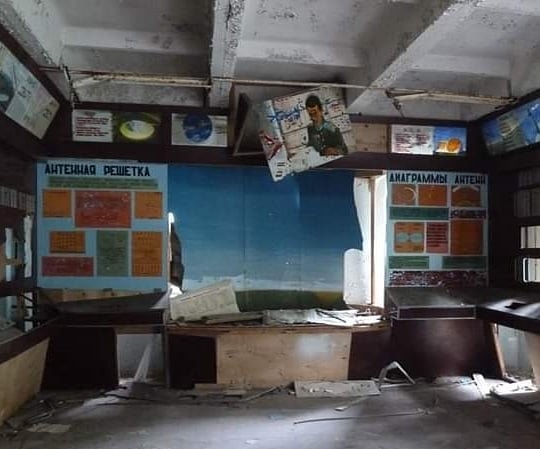

After leaving the military complex, we walked over to the residential part of town. Here we saw apartment buildings that would have once housed military families living in the town. These would have been top end apartments in their time, nothing but the best for Soviet military personnel. But now these buildings had mostly been stripped of anything of value – just an occasional ripped sofa or rusted oven remaining. Wallpaper was sliding off the walls in long strips, paint was curling up in hand sized flakes, floors were soft underfoot.

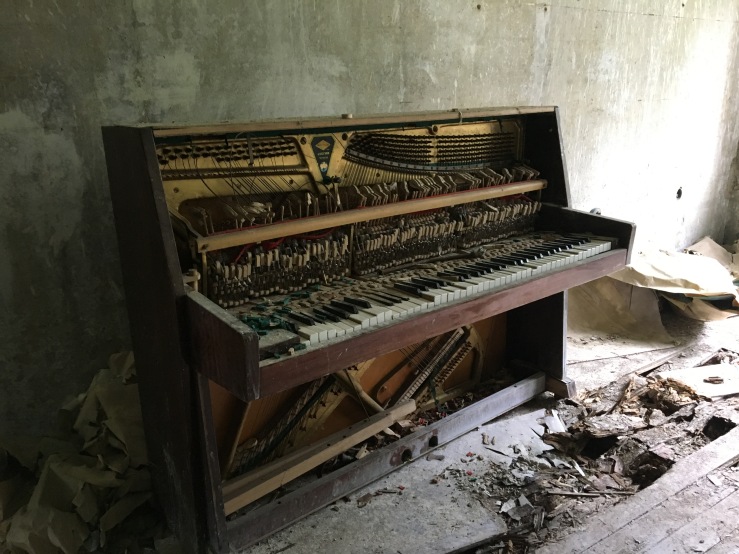
After our visit to Duga and the town of Chernobyl-2, we drove to Hotel Desiatka for lunch. Hotel Desiatka seems to be the only hotel / restaurant in the Exclusion Zone. It certainly did a brisk lunchtime trade in tour groups as the staff silently delivered and took away the set menu plates (soup, stew, baskets of sweet breads for dessert). Bottles of water and glasses of mors were available on the table to rehydrate after the warm morning walking around.
“What’s this?” my tablemates asked, eyeing the bright red glass of liquid suspiciously. “It’s mors,” I said, but maybe they thought I was speaking some kind of nonsense, because the conversation about what this drink could be continued throughout lunch. “It’s mors. It’s a Russian berry drink,” I said. “Yes,” they agreed, “it does taste like berries.” I should perhaps have made more of the fact that I spoke basic Russian and had lived in Moscow for three months and so had some knowledge of food and drink common in the region. Although in fact I’d completely forgotten about mors until I saw the glasses on the table and then the word popped into my head. Language is strange like that. I hadn’t thought about mors for years and then I saw the glass on the table and I knew immediately what it was and what it was called.

After lunch, we got back in the bus and drove towards the damaged reactor 4. We stopped at the roadside for our guide to point out the building housing (the now-decommissioned) reactors 1 and 2; and the New Safe Confinement (NSC) over reactor 4, and the other half of the building where reactor 3 had been operating. I had never actually realised that reactor 4 (where the accident took place) was in the same building as another reactor. Off to the right was a rusted construction site – the half-completed building that was intended to house reactors 5 and 6 – now abandoned.
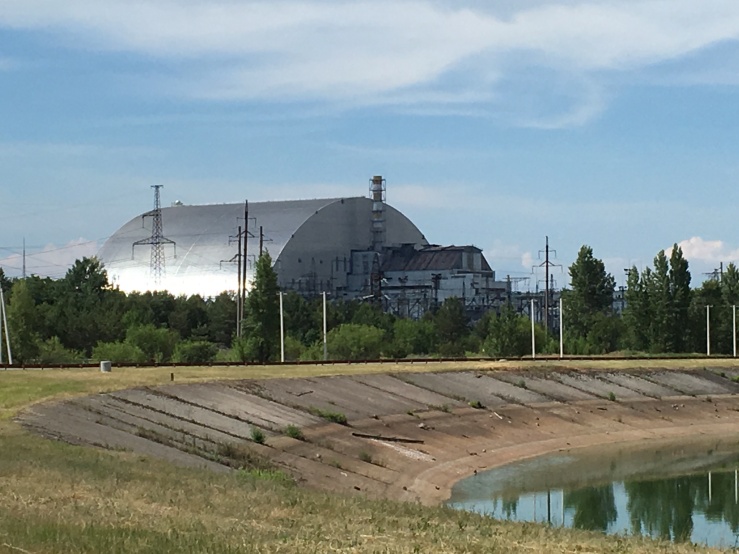
I thought this view from a distance was all we would see, so it was a surprise that when we got back into the bus, we continued on towards the reactor and the New Safe Confinement (NSC). I thought at first that we would drive up to the NSC, look at it out the window of the bus, and keep on driving, but no, we stopped, and got out of the bus for a photo opportunity up close to the NSC that shields the damaged reactor. The quiet ticking of the Geiger counters which had accompanied us during the day gathered speed as we moved into this more radioactive zone.
The area around reactor 4 has been the subject of intense cleaning operations, due to it being the epicentre of the explosion and also the target of intense building and reconstruction activity over the past few years, particularly the mammoth engineering effort that was the construction of the NSC. As they could not build the shelter directly over the reactor due to the levels of radioactivity, it was built on tracks and once it was complete, moved it into place over the reactor. This video shows the amazing feat of engineering and I feel a little pang of pride for my employer’s role in administering the Chernobyl Shelter Fund.
From NSC we moved on to view the cooling towers that were under construction for the never-completed reactors 5 and 6. I’ve seen cooling towers in the distance many times but never up close like this. Our guide emphasised the importance of following her instructions on where to walk, by pointing the Geiger counter at the area off the path (the ticking quickly gathered speed to a low-level shrieking), to demonstrate that this is still a radioactive area, and if we were taking a meandering route to get around, it was to avoid radioactive “hot spots”.
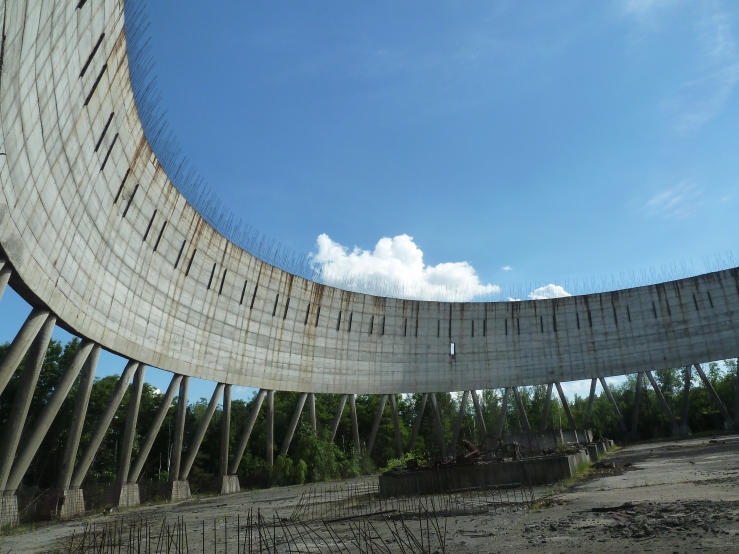


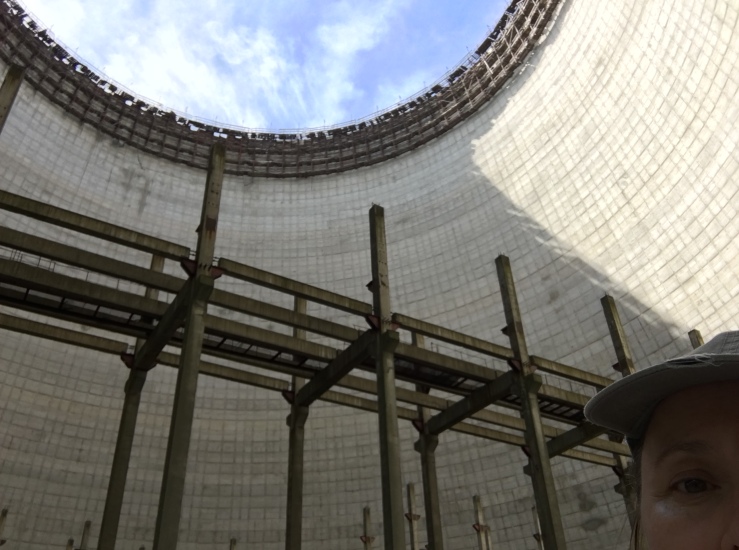
After the cooling towers we visited some nearby research centres by the cooling ponds for the reactors. Various studies had been done here on fish that were living in the ponds and some further studies on furry animals. The complex was not very interesting but I saw outside the fish research centre there was a grapevine growing over the door. I don’t know if when it was planted, but it was growing healthily, and had small bud-like grapes on its tips. That image stayed with me, because for all the greenery we had seen in the area, most of it seemed to be self-seeded forest trees or wildflowers or grasses – things that took the opportunity of not being cut back to grow and flourish and reproduce. But this grapevine – someone had to plant that. And it had persisted and flourished in its own way, with no one providing any care for it for 30-some years.
This was the end of our first day’s tour, so we headed back to Hotel Desiatka, stopping off first at the village shop where it was just our tour bus group and lots of checkpoint soldiers who were billeted somewhere else in the village. The soldiers got served first even if they came in after us – which makes sense, to look after your regulars first ahead of a bunch of tourists who are just buying water, beer and ice cream. (Actually the soldiers were also buying water, beer and ice cream. Although mostly beer.)
Dinner followed the same process as lunch. Salad. Stew. Sweet bread pastries. Water. Mors. We all had our eye on the clock as the sign at the bar advised “Alcohol will only be released between 19:00 and 21:00.” It was after 19:00 but dinner service was still going on and the woman I assume was the manager was helping get the dinner plates out so she wasn’t interested in being behind the bar. But sure enough, as soon as she was behind the bar and ready to release the alcohol, a small queue formed, and we enjoyed a cold bottle of “Biele Nochi” (white nights). At 20:40 we got another bottle, knowing that closing time was approaching. Sure enough, some fool came in at 21:05 and asked for beer. The barlady/manager gave them her best dead eye stare and said “Bar is closed.” I have to find out where this Soviet Customer Service School is that is still churning out graduates even now.
Here’s a thing they don’t tell you. There are lots of stray dogs in the exclusion zone. They seem friendly enough, mostly hanging around the checkpoints, so I guess the soldiers feed them or take care of them, but I was reminded several times on our trip of the Martin Cruz Smith novel, Wolves Eat Dogs, which was set in the Exclusion Zone. And what they also don’t tell you is that during the night, the dogs get together and do dog things, like bark and fight. And in a place as quiet as this, the sound of barking, snarling dogs is (at worst) going to keep you awake or (at least) give you unsettled dreams. My tip? Don’t forget to pack earplugs.

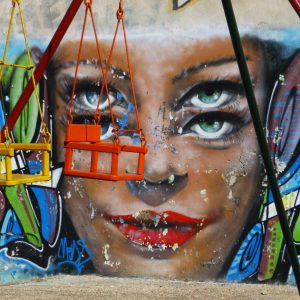


Fascinating essay and photos. I would have never guessed that tour buses actually visit Chernobyl. A somewhat unsettling thought. I sure hope the Geiger counters were working properly. You’re brave to go there, I’d have gone directly to Kiev.
LikeLike
Hi Pete, it’s certainly not a trip for everyone. I was reassured by our guide (her company gave her the nickname “the caretaker”) who used scare tactics to reinforce the safety aspects and keep us in a line. I saw people from other tour groups in short sleeves and short trousers, taking selfies sitting on the ground, picking leaves off trees – all behaviours we were told would put you at risk and which their tour leaders should have prevented.
LikeLiked by 1 person
I was in Kyiv during august but didn’t go to Chernobyl.. You’re really brave 🙂
LikeLike
I had seen the pictures of the abandoned city in magazines, etc. before. I didn’t realise it would be possible to visit, or at least, so easy to organise to visit. I didn’t feel brave – in fact sometimes when our guide was reinforcing the safety message I felt a little bit scared.
LikeLiked by 1 person